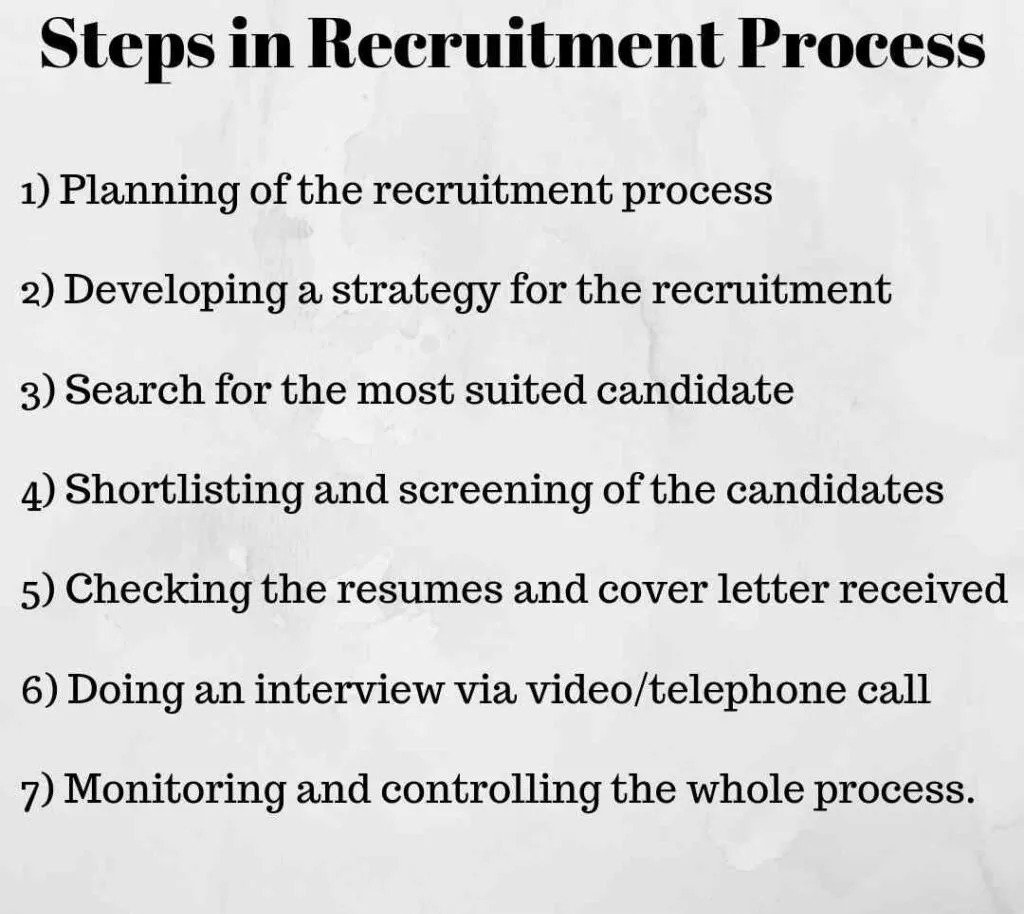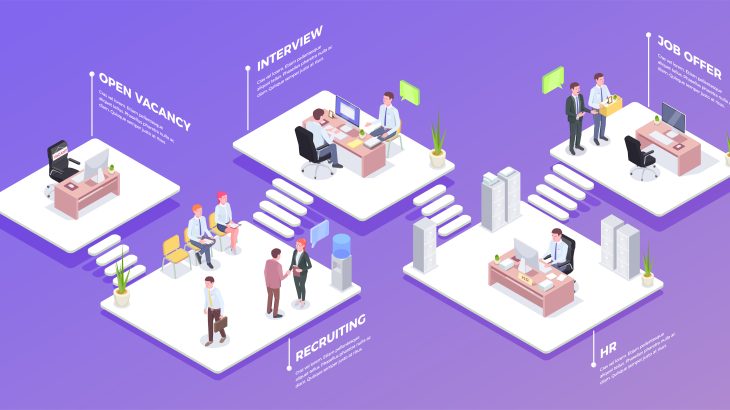Process of Recruitment
Recruitment Process is the process concerned with searching and attracting the best resources. To fill up the vacant positions in the concerned organization. Recruitment process is to enable us to select creative, innovative people. who have passion and potential.
The recruitment process is a process of identifying the jobs employ, analyzing the job requirements, reviewing applications, screening, shortlisting and selecting the right candidate. It is simply the process of attracting individuals on a timely basis, in sufficient numbers, and with appropriate qualifications, to apply for jobs with an organization.
In order to make the recruitment process effective, the HR team of a company must follow the 5 best practices explained below. These 5 practices ensure successful recruitment. In addition, these practices also ensure consistency and compliance in the process of recruitment.
Steps in the Recruitment Process

1. Planning Of The Recruitment Process.
It is served as the basis for the whole recruitment process, where the positions for which recruitment process is to be done are properly analyzed and presented. It includes job specifications and nature, qualifications, experience, and required skills for the job, etc.
A structured recruitment plan is compulsory to attract potential candidates from a pool of candidates. The potential candidates should be qualified, experienced with a capability to take the responsibilities required to achieve the objectives of the organization, The recruitment plan basically consists of the following functions- vacancy identification, analysis of the particular job, analysis of the job, description of the job, specification and evaluation of the job.
2. Developing A Strategy For The Recruitment
It is the second step in the recruitment process where a proper blueprint for the recruitment process is prepared and every task is undertaken according to it. After completing the preparation of job specifications and job descriptions, the next step is to decide which strategy to adopt for recruiting the potential candidates for the organization.
when preparing a recruitment strategy, the HR considers the following points −
- Make or buy employees
- Geographical area
- Types of recruitment
- Recruitment sources
The development of a recruitment strategy is a long process, but having the right strategy is necessary to attract the right candidates.
3. Search For The Most Suited Candidate
It is basically concerned with taking the decisions regarding the source for the recruitment process. There are basically 2 sources for this process: internal and external source of recruitment. This is the process of recruitment where the resources are selected depending upon the requirement of the vacant position. After the recruitment strategy is done, the searching for potential candidates will be initialized. This process consists of two steps −
- Starting off the process− Once the line manager verifies and permits the existence of the vacancy, the search for candidates starts.
- Media selection− Here, the organization selects the media through which the communication of vacancies reaches the prospective candidates.
The two main sources of selection are:
Internal Sources
Internal sources of recruitment mean to recruit employees within the organization through.
- Promotions
- Transfers
- Former Employees
- Previous Applicants
- Internal Advertisements (Job Posting)
- Employee Referrals
External Sources
External sources of recruitment mean to recruit employees outside the organization through −
- Direct Recruitment
- Employment Agencies
- Employment Exchanges
- Professional Associations
- Advertisements
- Campus Recruitment
4. Shortlisting And Screening Of The Candidates
This process follows the process of selecting the source of recruitment. Screening is the process of filtering the applications of the candidates for the further selection process.
Screening is an integral part of the recruitment process that helps in removing unqualified or irrelevant candidates, which were received through sourcing.
This process consists of 3 steps:
5. Checking The Resumes And Cover Letter Received
It is the first step involved in the screening process. In this process, the resumes of the candidates are checked and reviewed for the candidates’ work experience, education, and overall background matching the requirement of the job
While reviewing the resumes, an HR keep the following points in mind, to ensure better screening of the potential candidates −
- Reason for change of job
- Longevity with each organization
- Long gaps in employment
- Job-hopping
- Lack of career progression
6. Doing An Interview Via Video/Telephone Call
Conducting video or telephonic interviews is the second step of screening candidates. In this process, after the resumes are screened, the candidates are contacted through phone or video by the hiring manager. This screening process has two outcomes −
- It helps in verifying the candidates if they are active and available.
- It also helps in giving a quick insight into the candidate’s ability to answer interview questions, attitude, and communication skills.
7. Monitoring And Controlling The Whole Process
It is the last step in the process of recruitment and is considered as one of the most important steps in the recruitment process as it keeps a check whether all the activities are going in accordance with the predetermined plans. In this process, the effectiveness and validity of the process and methods are assessed. Recruitment is costly, hence it is important that the performance of the recruitment process is thoroughly evaluated.
The costs incurred in the recruitment process are to be evaluated and controlled effectively. These include the following −
- Salaries to be paid to the Recruiters
- Administrative expenses and Recruitment overheads
- Advertisements cost and other costs incurred in recruitment methods, i.e., agency fees.
- Cost incurred in recruiting suitable candidates for the final selection process
- Overtime and Outstanding costs, while the vacancies remain unfilled
- Time spent by the Management and the Professionals in preparing job description, job specifications, and conducting interviews.





